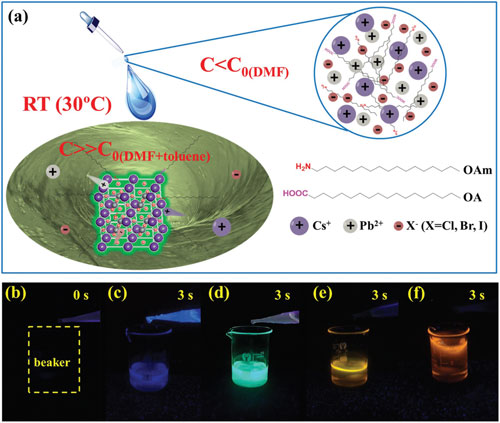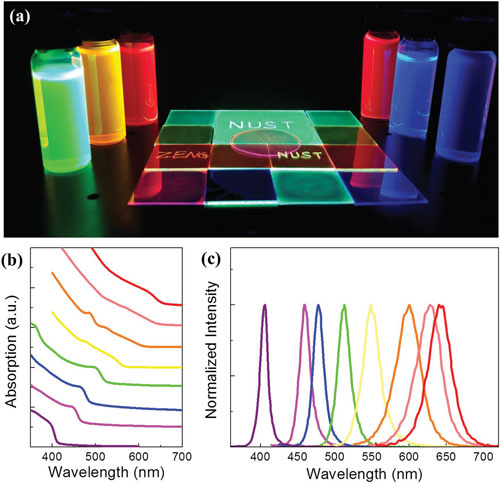| Posted: Mar 07, 2016 | |
Inorganic perovskite quantum dots for lighting and displays |
|
| (Nanowerk Spotlight) Luminescent quantum dots (LQDs), which possess high photoluminescence quantum yields, flexible emission color controlling, and solution processibility, are promising for applications in lighting systems (warm white light without UV and infrared irradiation) and high quality quantum dot displays. | |
| However, the commercialization of LQDs has been held back by the prohibitively high cost of their production. Currently, LQDs are prepared by the HI method, requiring at high temperature and tedious surface treating in order to improve both optical properties and stability. | |
| In a breakthrough approach, researchers have now succeeded in preparing highly emissive inorganic perovskite quantum dots (IPQDs) at room temperature. | |
| "Our synthesis technique is designed according to supersaturated recrystallization, which is operated at room temperature, within few seconds, free from inert gas and injection operation," Professor Haibo Zeng, Director of the Institute of Optoelectronics & Nanomaterials at Nanjing University of Science and Technology, tells Nanowerk. "Although formed at room temperature, our IPQDs’ photoluminescence have quantum yields of 80%, 95%, 70%, and very small line-widths of 35, 20, and 18 nm for red, green, and blue emissions." | |
 |
|
| Schematic of RT formation of IPQDs (CsPbX3 (X = Cl, Br, I)). a) The SR can be finished within 10 s through transferring the Cs+, Pb2+, and X- ions from the soluble to insoluble solvents at RT without any protecting atmosphere and heating. C: ion concentration in different solvents. C0: saturated solubilities in DMF, toluene, or mixed solvents (DMF+toluene). b) Clear toluene under a UV light. Snapshots of four typical samples after the addition of precursor ion solutions for 3 s, blue (c, Cl:Br = 1), green (d, pure Br), yellow (e, I:Br = 1), and red (f, I:Br = 1.5), respectively. (Reprinted with permission by Wiley-VCH Verlag) (click on image to enlarge) | |
| Zeng and his team have reported their findings in the February 29, 2016 online edition of Advanced Functional Materials ("CsPbX3 Quantum Dots for Lighting and Displays: Room-Temperature Synthesis, Photoluminescence Superiorities, Underlying Origins and White Light-Emitting Diodes"). | |
| The room temperature procedures developed by the researchers make scaled production possible so that gram-scale of quantum dots can be synthesized easily with very low cost and in short time. | |
| Already applied in the production of some organic nanoparticles, under the assist of surfactants, a supersaturated recrystallization (SR) process can be applied to fabricate QDs with well size and composition controls in solutions, especially when considering the ionic crystal features of halide perovskites. | |
| Zeng explains the process: "In supersaturated recrystallization, that is, when the constrainedly sustentative nonequilibrium state of a soluble system is activated by an accident, for example, stirring or impurity, the supersaturated ions will precipitate in the form of crystal, which is frequently observed in natural minerals, alloys, and ion solutions. Such spontaneous precipitation and crystallization reactions will not stop until the system reaches an equilibrium state again." | |
| He points out that the operation of his team's SR synthesis is very simple, and can be summarized as transferring various inorganic ions from their very good into very poor solvents. | |
| "So, when considering supersaturation-induced recrystallization and no usage of heating, it seems to be similar to solarizing seawater to obtain edible salt, which has been used for a long time in human history," Zeng notes. "But the key point of SR process, the obtaining of supersaturated state, is achieved by using transfer from good into poor solvents in our work, but not the evaporation of solvent, which could be the reason why our IPQDs can be formed completely at room temperature and only need trace amount of energy." | |
 |
|
| Controllable photoluminescence. a) Optical images of solution and film samples with different bandgaps under a 365 nm UV lamp. b) Optical absorption and c) photoluminescence spectra of IPQDs with different composition. (Reprinted with permission by Wiley-VCH Verlag) | |
| Although developed only recently, inorganic halide perovskite quantum dot systems have exhibited comparable and even better performances than traditional QDs in many fields. With this novel room-temperature preparation technique, IPQDs' superior optical merits could lead to promising applications in lighting and displays. | |
| "Though more investigations are needed to reveal the correlations between structural – especially the surface states – and physical properties, our findings will provide good references and enhance researchers’ understanding of this quantum dot system, pushing it to a new research paradigm in the field of optoelectronic devices, as well as sensors and memristors," concludes Zeng. | |
 By
Michael
Berger
– Michael is author of three books by the Royal Society of Chemistry:
Nano-Society: Pushing the Boundaries of Technology,
Nanotechnology: The Future is Tiny, and
Nanoengineering: The Skills and Tools Making Technology Invisible
Copyright ©
Nanowerk LLC
By
Michael
Berger
– Michael is author of three books by the Royal Society of Chemistry:
Nano-Society: Pushing the Boundaries of Technology,
Nanotechnology: The Future is Tiny, and
Nanoengineering: The Skills and Tools Making Technology Invisible
Copyright ©
Nanowerk LLC
|
|
|
Become a Spotlight guest author! Join our large and growing group of guest contributors. Have you just published a scientific paper or have other exciting developments to share with the nanotechnology community? Here is how to publish on nanowerk.com. |
|
